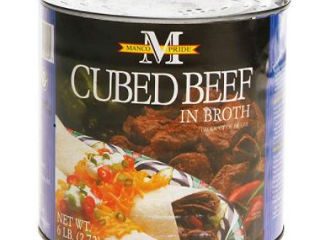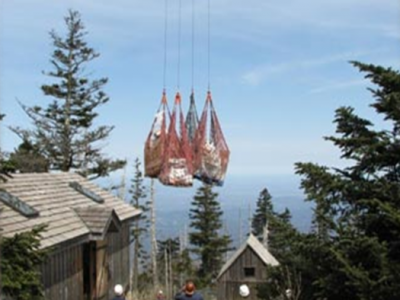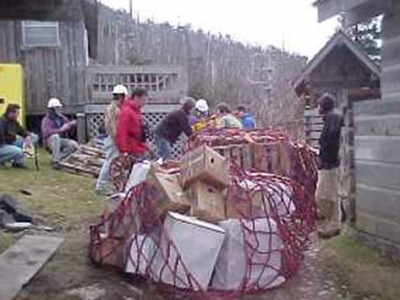| Outbreak: Tennessee Mountain Lodge | |
|---|---|
| Product: Canned Beef in Gravy | Investigation Start Date: 6/30/2010 |
| Location: Multi-state | Etiology: Clostridium perfringens & Staphylococcus aureus |
| Earliest known case onset date: 6/19/2010 | Latest case onset date: 6/23/2010 |
| Confirmed / Presumptive Case Count: 1/52 | Positive Environmental Samples: 0 |
A suspected outbreak of foodborne illness was reported at a lodge in the Great Smoky Mountains National Park. Set meals are served at the lodge at 6 pm and 8 am, each consisting of multiple canned/packaged items. The lodge is reached by rugged foot trails and provisions for the entire season are ordered in advance and dropped by helicopter one time in the spring. Anecdotal reports suggested that no vegetarians had become ill.
Visitors were asked to visit Park Headquarters after leaving the lodge and those that had already departed were contacted by phone. Interviews revealed uniform symptoms with a tight onset period and rapid resolution; none of the visitors interviewed in-person were able to provide a stool specimen. Among 94 identified visitors to the lodge during the event period, 53 reported becoming ill during or following their trip. Two menu items had significantly high odds ratios for both event days: beef in gravy and mashed potatoes.
A single specimen was eventually procured in coordination with another state’s Department of Health, which revealed both Staphylococcus aureus and Clostridium perfringens. The symptoms and incubation period of ill visitors were consistent with C. perfringens intoxication, and the anaerobic bacterium has often been associated with canned meat products. It was theorized that the annual provision delivery may have been the source of the C. perfringens contamination if a can’s seal dislodged during the provision drop, allowing contamination before resealing when stacked for storage.
On a Monday in June, the Tennessee Department of Health’s East Regional Office (ETRO) received a report of severe gastrointestinal symptoms at a lodge in the Great Smoky Mountains National Park (GSMNP). Consultation with the National Park Service (NPS) indicated early morning onset among 7 visitors, but no administrative or food service staff were ill.
The lodge is reached by rugged foot trails and there are very limited facilities/activities onsite. Set meals are served at 6 pm and 8 am; each consists of multiple canned/packaged items that are prepared daily. Due to the inaccessibility of the site, provisions for the entire season are ordered in advance and dropped by helicopter one time in the spring. Weekly deliveries of fresh foods for the staff are made by pack llama.
A food- or water-borne pathogen was suspected based on the symptoms reported. Environmental exposures including recreational water and animal contact were included on the interview tool, in addition to items from the dining hall menu. Most visitors had departed by the time of report and could not be intercepted; a few visitors planned to descend the following day and were asked to visit Park Headquarters.
Interviews revealed uniform symptoms with a tight onset period, consistent with a pre-formed bacterial toxin. The rapid onset appeared to rule out person-to-person transmission or a traditional food-borne enteric infection. Anecdotal reports suggested that no vegetarians had become ill. None of the visitors interviewed at GSMNP were currently symptomatic and stool specimens could not be collected. Additional interviews were conducted by telephone with registered lodge visitors for the 2-day event period and bookended dates.
Visitors on the bookended dates reported no illness. Among 94 identified visitors during the event period, 53 reported becoming ill during or following their trip to the lodge, with all reporting lower gastrointestinal symptoms. There was no significant difference in symptoms or duration by visitors’ sex or age. An epidemic curve indicated that the largest proportion developed symptoms in the early morning hours of each event day, consistent with the working hypothesis that a nightly food item was the source of intoxication.
The median incubation period was 12 hours; however, this varied significantly by date of lodging (13 vs. 10.4 hours on Event-Day 1 and Event-Day 2, respectively). The decreased incubation period and an increased attack rate among visitors on Event-Day 2 both supported the idea that those visitors might have received a greater dose of the causative agent. Duration of illness ranged widely (from a single diarrheal episode to more than 4 days), but the median duration was 15 hours.
No environmental exposures were identified and only two items had significantly high odds ratios for both event days: beef in gravy and mashed potatoes. Although almost exclusively consumed together, when odds ratios were calculated for absolute consumption of food items, the beef was clearly implicated, producing an odds ratio of 17.667 (95% CI: 1.914, 163.027).
ETRO coordinated with the NPS and other states’ departments of health to attempt timely collection of stool specimens from visitors that reported ongoing illness. A single specimen was procured, revealing both Staphylococcus aureus and Clostridium perfringens. The latter was considered the more likely causative agent; the symptoms and incubation period of ill visitors were consistent with C. perfringens intoxication, and the anaerobic bacterium has often been associated with canned meat products.
Despite a strongly implicated food item, a lab-confirmed source could not be identified. Lodge policy requires that any leftover prepared food be immediately disposed of and all food containers washed and flattened to avoid attracting bears and smaller nuisance animals. However, administrators described occasional storage of unprepared leftover foods. Upon re-interview, food service workers were able to confirm that an additional can of beef was opened on Event-Day 1 and approximately of it prepared; the remainder was stored in a sealed, refrigerated container and added to the cans of beef prepared on Event-Day 2.
The annual provision drop may have been the source of the C. perfringens contamination. Although palletized to reduce can damage, lodge administrators reported that occasionally cans would pop open on impact. It was theorized that a can’s seal may have dislodged briefly during the provision drop, allowing unnoticeable contamination with the ubiquitous bacterium before resealing when stacked for storage.
The lodge’s inaccessibility posed unique challenges for investigators, Park administrators, and the lodge concessioner. Although none of the visitors required medical intervention, the extremely large numbers of out-of-state visitors to GSMNP and nearby tourist attractions (more than 10 million annually) present a concentrated area of risk for a multi-state outbreak.




